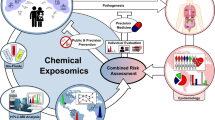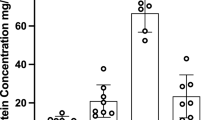Abstract
Among the eleven drugs or chemicals which are well-documented human teratogens, eight (or their main metabolites) are weak acids whereas none is a weak base. Moreover, 23 out of 32 acids tested have been found to be teratogenic in at least one animal species1. The acidic property of drugs may therefore be an important determinant of teratogenicity. We demonstrate here that the intracellular pH (pHi) of the mouse and rat embryo is higher than that of maternal plasma, as determined by the relative accumulation of dimethadione. The antiepileptic drug valproic acid and its pharmacologically active unsaturated metabolite accumulate in embryonic tissue to higher concentrations than in maternal plasma, whereas the essentially neutral amide of valproic acid (valpromide) or ethosuximide do not accumulate in the embryo; we further demonstrate in the rat that the pHi; of the embryo decreases with advancing gestation; in general agreement with the pH partition hypothesis, the exposure of the embryo to valproic acid also decreases significantly during that period. Furthermore, the amides of two weak acid teratogens, valpromide and methoxyacetamide, and the imide ethosuximide, are much less teratogenic than their acid counterparts. Our results suggest that weakly acidic drugs, by virtue of their physico-chemical nature, accumulate in the early embryo with its relatively high pHi.
This is a preview of subscription content, access via your institution
Access options
Subscribe to this journal
Receive 51 print issues and online access
$199.00 per year
only $3.90 per issue
Buy this article
- Purchase on Springer Link
- Instant access to full article PDF
Prices may be subject to local taxes which are calculated during checkout
Similar content being viewed by others

References
Freese, E. et al. Teratology 20, 413–440 (1979).
Waddell, W. & Butler, T. J. clin. Invest. 38, 720–729 (1959).
Robert, E. & Rosa, F. Lancet ii, 1142 (1983).
Koch, S., Jäger-Roman, E., Rating, D. & Helge, H. J. Pediat. 103, 1007 (1983).
Nau, H., Zierer, R., Spielmann, H., Neubert, D. & Gansau, Ch. Life Sci. 29, 2803–2814 (1981).
Kao, J., Brown, N. A., Schmid, B., Goulding, E. H. & Fabro, S. Teratogen., Carcinogen., Mutagen. 1, 367–382 (1981).
Ong, L. L. et al. Fundamental appl. Tox. 3, 121–126 (1983).
Nau, H. et al. J. chromat. 226, 69–78 (1981).
Brown, N., Holt, D. & Webb, M. Tox. Lett. 22, 93–100 (1984).
Ritter, E. J., Scott, W. J., Randall, J. L. & Ritter, J. M. Teratology 32, 25–31 (1985).
Keberle, H., Loustalot, P., Maller, R. K., Faigle, J. W. & Schmid, K. Ann. N.Y. Acad. Sci. 123, 253–265 (1965).
Danielsson, B. R. G., Ghantous, H. & Dencker, L. Acta pharmac. tox. 55, 410–417 (1984).
Tagashira, E. et al. Japan J. pharmac. 31, 563–571 (1981).
Willhite, C. & Shealy, F. J. natn. Cancer Inst. 72, 689–694 (1984).
Löscher, W. & Nau, H. Neuropharmacology 24, 427–435 (1985).
Sullivan, F. M. & McElhatton, P. Tox. appl Pharmacol. 40, 365–378 (1977).
Fabro, S., Shull, G. & Brown, N. A. Teratogen., Carcinogen., Mutagen. 2, 61–76 (1982).
Nau, H., Löscher, W. & Schäfer, H. Neurology 34, 400–401 (1984).
Helm, F.-Ch., Frankus, E., Fridereichs, E., Graudums, I. & Flohe, L. Arzneimittel.-Forsch., 31, 941–949 (1981).
Nau, H. & Löscher, W. Fundamental appl. Tox. 6, 669–676 (1986).
Mirkin, B. L. & Singh, S. in Perinatal Pharmacology and Therapeutics (ed. Mirkin, B. L.) 1–69 (Academic, New York, 1986).
Mast, T. J., Cukierski, M. A., Nau, H. & Hendrickx, A. G. Toxicology 39, 111–119 (1986).
Author information
Authors and Affiliations
Rights and permissions
About this article
Cite this article
Nau, H., Scott, W. Weak acids may act as teratogens by accumulating in the basic milieu of the early mammalian embryo. Nature 323, 276–278 (1986). https://doi.org/10.1038/323276a0
Received:
Accepted:
Issue Date:
DOI: https://doi.org/10.1038/323276a0
This article is cited by
-
Characterization of the anticonvulsant profile and enantioselective pharmacokinetics of the chiral valproylamide propylisopropyl acetamide in rodents
British Journal of Pharmacology (2003)
-
Comparative teratogenicity of di-n-butyltin diacetate with n-butyltin trichloride in rats
Archives of Environmental Contamination and Toxicology (1992)
Comments
By submitting a comment you agree to abide by our Terms and Community Guidelines. If you find something abusive or that does not comply with our terms or guidelines please flag it as inappropriate.


